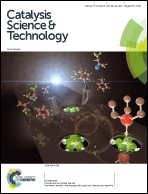Acidity and accessibility studies of desilicated ZSM-5 zeolites in terms of their effectiveness as catalysts in acid-catalyzed cracking processes†
Abstract
The structural, textural and acidic characteristics of hierarchical ZSM-5 (Si/Al = 18–32), obtained with two desilication approaches, and the effect of these treatments on the reactivity in various cracking reactions of variable feedstock size and severity have been investigated. Emphasis is given to understanding the accessibility of acid sites; this was investigated by textural analysis, FTIR probe molecules (pyridine, trimethylacetonitrile and 2,4,6-trimethylpyridine) and reactions involving n-decane, 1,3,5-triisopropylbenzene (TIPB), and low and high-density polyethylene, LDPE and HDPE, respectively. Higher surface areas and a narrower pore size distribution were obtained for NaOH&TBAOH-treated materials, comparing to NaOH-treated ones. FTIR studies of pivalonitrile and collidine adsorption correlate well with the mesopore surface area. For n-decane cracking activity, the acid strength is a determining factor, revealing that the NaOH&TBAOH treatment gave stronger sites than NaOH, but lower than the native zeolite. In contrast, the TIPB cracking activity was improved by the developed mesoporosity of the alkaline treated zeolites, and this was correlated to the pivalonitrile and collidine accessibility factors. During the n-decane and TIPB cracking, hydrogen transfer reactions were reduced, leading to high olefin production for the NaOH&TBAOH materials due to the shorter microporous paths after desilication. The increased accessibility of the acid sites also leads to an enhanced cracking activity of polyethylenes at low conversions, as determined by a decrease in the T5% and T50%; both parameters are linearly dependent on the pivalonitrile and collidine accessibility factors, for LDPE and HDPE. The T5% for HDPE is more influenced by the accessibility factors than it is for the LDPE. This is interpreted to be the result of the branching degree of HDPE and LDPE; linear HDPE is more sensitive to the enhanced number of pore mouths of ZSM-5 channels on the mesopores. At high conversion, the influence on the T50% of the accessibility factors for HDPE and LDPE is weaker, suggesting that the cracking at this stage involves intermediate molecules of smaller size with fewer diffusional limitations. With respect to our own prior work, the chosen zeolite and the cracking of polyolefins gave more pronounced differences for the hierarchical ZSM-5.

- This article is part of the themed collection: 2017 Catalysis Science & Technology HOT Articles


 Please wait while we load your content...
Please wait while we load your content...